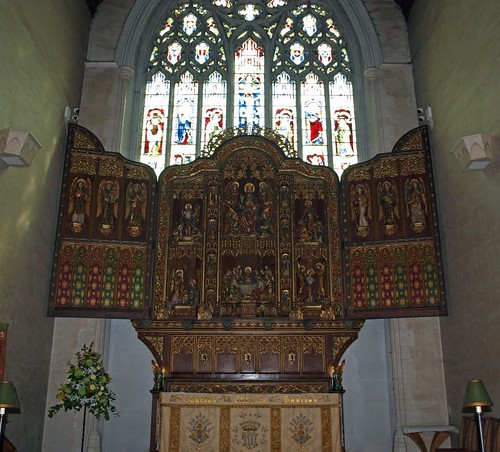ST JOHN THE BAPTIST. Epping has no medieval church. But when it came to building a parish church of sufficient size, in 1889, the authorities were wise in the choice of their architects. They went to Bodley & Garner and got a church of remarkable dignity if not striking originality. The outstanding feature is the tower erected only in 1908-9, also by Badley. It stands at the street corner separated from nave and aisle which face the High Street with Dec windows. The tower is broad and strong with two large bell-openings on each side and three big battlements. It is all very serious, and no light relief is permitted. The motifs inside, e.g. the arcade pier and arches, are in a correct East Anglian C14th tradition. Much trouble has also been taken over the furnishing of the church. Reredos by Bodley and Hare, 1909; Rood Screen also by Bodley. - Stained Glass by Kemps (E window 1890, s aisle a window 1902).
EPPING. In the long and broad highway of this quaint market town is the very old and the new. A little before the road leaves the dense forest to skirt a wide common it passes Amesbury Banks, an ancient British plateau camp which some authorities claim as the scene of Boadicea’s last fight with the Roman legions. The camp covers 12 acres, its six-foot rampart 800 yards round, and the ditch within 10 feet deep and 20 wide. On one side is a depression through which ran a stream which provided the water for the defenders.
A double avenue of elms marches with the road across the common into the town. The wooden pens for animals on market day, and the old coaching inns and cottages, give the place an old-world look, but the magnificent church is modern. Its splendid pinnacled tower stands apart from it, with niches from which look down statues of saints and angels and one who was neither: Augustine, Alphege, Alban, Theodore, Michael, Gabriel, Uriel with a trumpet, and Archbishop Laud.
There is a great triptych behind the altar, and a pulpit with statues of the Evangelists. In a chapel is a gem of modern craftsmanship, a jewelled aumbry of copper with angels adorning it. The glass in one of the windows tells the story of the church, showing Henry the Second granting the manor of Epping with the tiny chapel of St John to the Abbot of Waltham, his jewelled crozier in his hand and a monk in a blue robe attending. In the scene is a dog, with other animals symbolising the neighbouring forest.
A double avenue of elms marches with the road across the common into the town. The wooden pens for animals on market day, and the old coaching inns and cottages, give the place an old-world look, but the magnificent church is modern. Its splendid pinnacled tower stands apart from it, with niches from which look down statues of saints and angels and one who was neither: Augustine, Alphege, Alban, Theodore, Michael, Gabriel, Uriel with a trumpet, and Archbishop Laud.
There is a great triptych behind the altar, and a pulpit with statues of the Evangelists. In a chapel is a gem of modern craftsmanship, a jewelled aumbry of copper with angels adorning it. The glass in one of the windows tells the story of the church, showing Henry the Second granting the manor of Epping with the tiny chapel of St John to the Abbot of Waltham, his jewelled crozier in his hand and a monk in a blue robe attending. In the scene is a dog, with other animals symbolising the neighbouring forest.



No comments:
Post a Comment